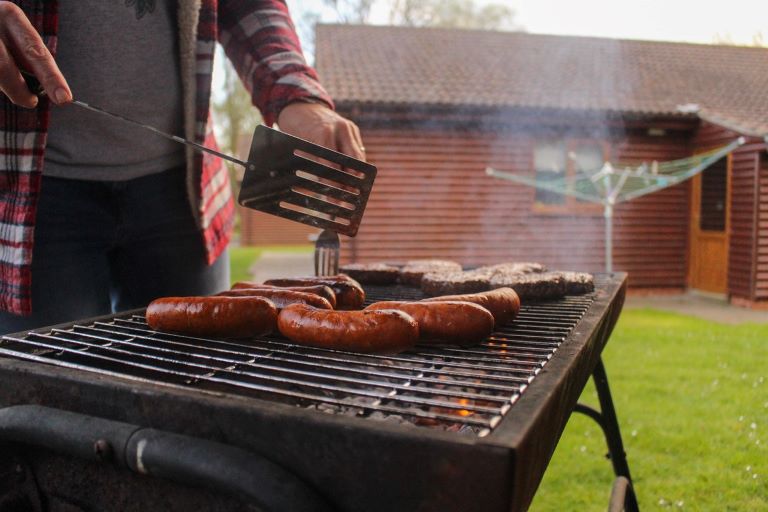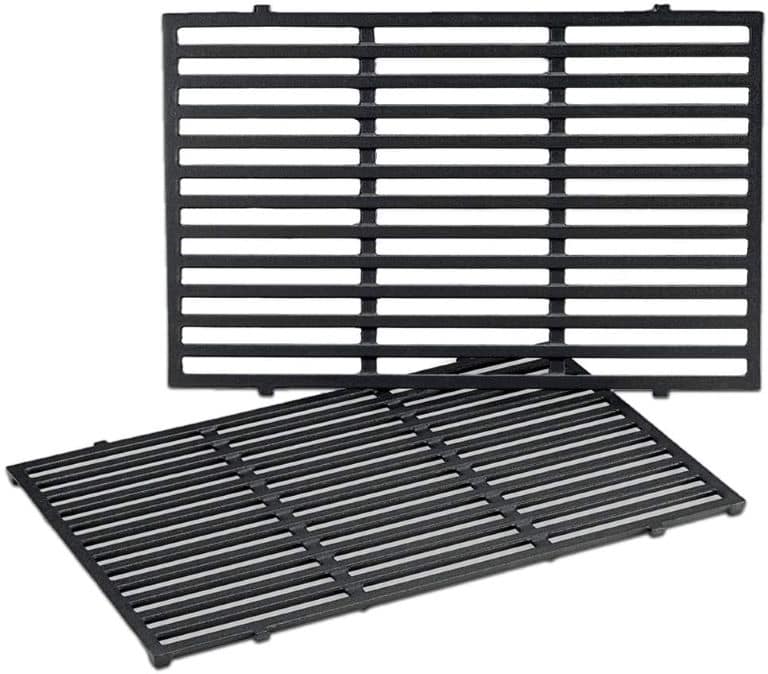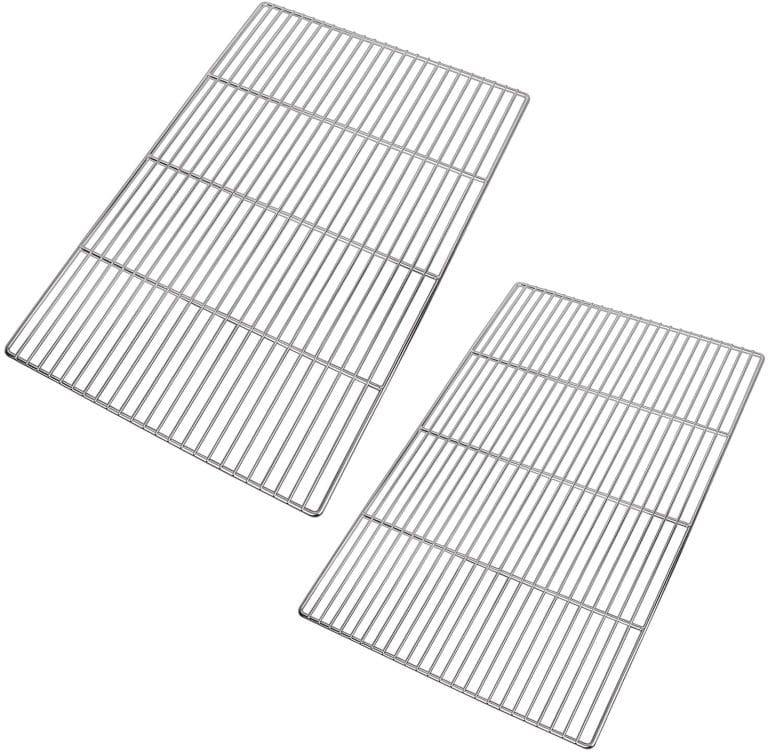
When it comes to grilling, is there really any difference between cast iron vs stainless steel grill grates? If so, then how would you choose which material is best for you?
The answers to these questions can often come down to preference as well as where you’ll be doing most of your grilling. A barbecue will most often have cast iron grates. However, backyard fire pits often use stainless steel. As do portable fire pits.
Of course, both options have their pros and cons and at the end of the day, both materials have their place in the grilling world.
Cast Iron vs Stainless Steel Grill Grates
Before choosing cast iron or stainless steel, it’s beneficial to weigh the pros and cons of each so you can take a good look at what makes each one a better choice over the other.
Advantages of Cast Iron and Stainless Steel
| Cast Iron Pros | Stainless Steel Pros |
| Durable | Lightweight |
| Long Lasting | Excellent resistance to rust |
| Excellent heat retention | Easy to clean |

Cast Iron Pros
Cast iron grill grates are durable and can last a lifetime with when properly cared for. Whether you’re camping at a campground or at a well used primitive campsite in the middle of the forest, you are sure to find an old cast iron grill grate that has been left near the fire pit.
Although cast iron grill grates will rust when exposed to the elements, it will take a very long time for it to deteriorate. Most often a quick clean before and after using the grill will keep the grates in tip top condition.
In addition to its durability and long life span, cast iron has excellent heat retention properties meaning that once the grill grates have heated up, they will hold onto that heat and take a long time to cool off. This is obviously a great feature to have when you’re cooking food and is one of the main reasons that cast iron is so popular in the grilling world.
Being able to hold very high temperatures also makes cast iron ideal for searing meats so you get that crisp outside to your steak while cooking the inside to perfection.
Stainless Steel Pros
Stainless steel has also become very popular for grill grates and can often be found as the main material used in grilling tripods and portable fire pits. A big reason for its popularity has to do with its lightweight. Being lightweight makes carrying and transporting these grills easy and also reduces the load on the tripod legs when setting up over a campfire.
Another added bonus for stainless steel is that it takes a long time to corrode so it can be left outside in the rain without the risk of rust and corrosion taking over and ruining your grill in the short term.
The smooth finish of stainless steel also makes cleaning it easier than cast iron. A quick scrape with a grilling brush or wipe down with a wet cloth will normally be enough to clean a stainless steel grill after using it. There is no need to season a stainless steel grill grate either, as the surface is designed to be non-stick.
Disadvantages of Cast Iron and Stainless Steel
| Cast Iron Cons | Stainless Steel Cons |
| Heavy | Expensive |
| Needs proper care to avoid rust | Low heat retention |
| Harder to clean | Short life cycle |
Cast Iron Cons
As with anything, there are pros and cons to the use of cast iron for grill grates too. The same properties that make cast iron so durable, also lead to it being quite heavy. While this isn’t so much of an issue for barbecues that mostly stay in one place on the deck, it can be a little much for carrying around on a camping trip.
Cast iron will rust and corrode more easily than stainless steel. To avoid this, general maintenance and care is needed after each use. This post goes into the details of how to keep your cast iron grill grates clean to avoid rust. Keeping them free of moisture and properly seasoned after each cook will help to avoid unwanted problems.
Cleaning of cast iron can be more difficult than stainless steel. The easiest time to clean the grill will be right after cooking, while the grates are still warm. If foods are allowed to cool off on the grill they will often stick to it and be more difficult to remove. This also leads to the need for deeper cleaning which leads to more re-seasoning efforts for the cast iron grill grates.
Stainless Steel Cons
Although stainless steel is more rust resistant than cast iron, there are a few other drawbacks that might have you thinking twice before choosing it for your grill grates.
Number one is cost. The manufacturing of stainless steel grill grates requires is a little tougher process and because of this, they are in general more expensive than cast iron.
Another difference is that the stainless steel actually does not retain heat as well as cast iron. This makes it less desirable for grilling, but also less effective at keeping foods warm once the heat source has been removed.
While stainless steel is more rust and corrosion resistant than cast iron, that doesn’t necessarily mean that the grill will last longer. That’s because stainless steel is less durable and can easily be bent and damaged through regular wear and tear. Cast iron is more rigid which means it can take a beating without warping.

What Kind of Grates are best for Gas Grills?
The superior heat retention of cast iron makes it the go-to for gas grills. This makes cooking food at an even temperature easy while also being able to keep food warm for quite some time after the grill has been shut off. Plus there is no comparison in the grilling marks left on your burgers and steaks. Cast iron gives them a definitive grill mark with crisp edges and a tender middle.
Cast iron is the dominant material used for making Swivel Grills as well as all types of cowboy campfire cooking equipment. The tough, rustic look meets the desired aesthetics for this historic way of cooking, but it is also heavy duty and durable which is great for all types of camping trips.
What Foods Cook best on Cast Iron?
I’ll start by saying that all foods can cook on both materials. Having said that, some foods are easier to cook on cast iron grill grates due to the heat needed or the spacing of the grilling bars.
Typically, the grilling bars are spaced closer together on cast iron grills. This makes them better at cooking things like vegetables that could otherwise slip through the cracks and fall into the fire.
Cast iron is also more popular when cooking meats like steak and burgers because the high heat retention and distribution gives meat defined grilling marks which look great and also add flavor.
What Foods Cook best on Stainless Steel?
Larger vegetables like full size baked potatoes and peppers cook great on stainless steel grills since they are large enough to avoid falling through the grilling bars. A full size pizza can also easily cook over stainless steel and will not burn where the grill is touching.
Chicken, pork chops and burgers also cook just fine on stainless steel, although the grill marks will be less pronounced.
Cast Iron vs Stainless Steel Grill Grate Verdict
After weighing all of the pros and cons of cast iron and stainless steel grill grates, you might still be wondering which one is best for you. The truth is, there is no right or wrong answer. Both will work perfectly fine to cook any foods you want.
The ultimate decision will likely come down to preference and budget.
If you like to leave the grill outside and exposed to rain, snow and a lot of humidity, then a stainless steel grill will be best for you.
But, if you need to have those perfect grill marks on your steak and don’t mind a little extra care and maintenance, then I’d go with a cast iron grill grate.
The choice is yours! Happy grilling and Bon Appetit!
We love writing about the things that make a real difference in your outdoor experience. Some of the links in this post are affiliate links in which case we may earn a small commission at no extra cost to you if you make a purchase. We truly appreciate you taking the time to read our content and hope it has added value to your next camping and outdoor adventure.




